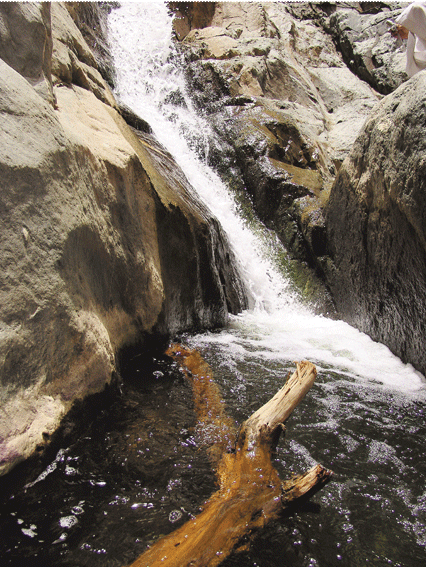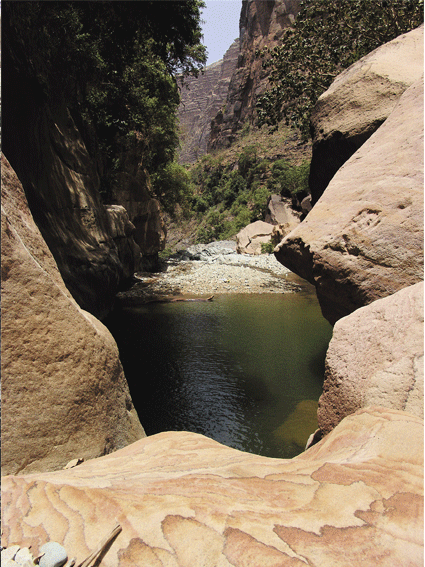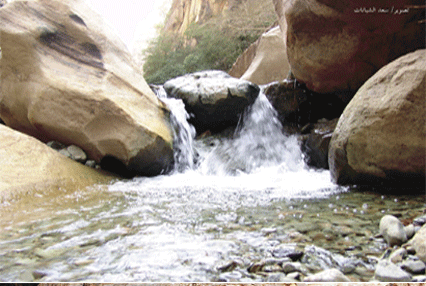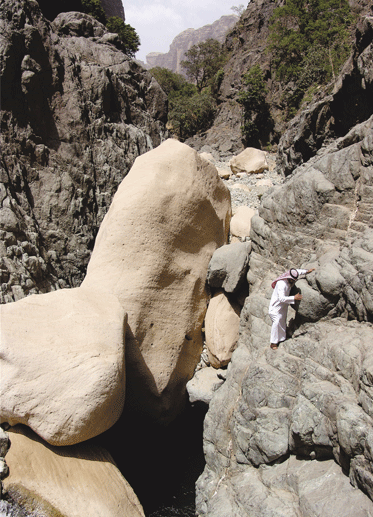
 Lajab’s Valley:
Lajab’s Valley:
Jazan Is Dashing in Its Nature
Birds dwell in the fascinating nature while the black Mountain (Jabal Al-Aswad) rises to the echelon of creativity.
Jizan: Saad Abdulaziz Al Shabanat
“Lajab” means “mixture of sounds”. It s notable that the visitors to the valley almost can’t hear their companions’ voices; the mixture of birds’ chirp and twitter , blending with water- falls, overpower all sounds in the valley; that was the reason for giving it that name.
The valley is a hard rocky road for visitors it forces them to give up the vehicle and continue walking.
The slope of streams between rocks, brooks, rivulets and the sparkling waterfalls create a magnificent harmony with the humming birds. As a result, time flies quickly as the visitors walk with pleasure.
The sight of the curvy shades of red in the rocks appears like a rainbow. The narrow passage widens in some places up to 100 m, as astonishment over the valley’s beauty heightens, with the colorful rocks inevitably drawing the visitors’ attention.
The two mountains surrounding the valley are approximately 300 m. high. On both sides of the valley, there is a variety of trees and rare plants.
The harmony of the branches of the trees on the mountainsides form a lovely image of the hanging gardens that captivate the mind in a mild cold weather. The valley’s location at 1000 meters above sea level and being almost shielded from the sun all day except at noontime make the weather relaxing.
Hours pass without boredom; the joy derived cures fatigue and fulfills the desire to worship God and think about creation.
On the way back to the valley you take pleasure in climbing the rocks, enjoying the images of birds flying and colorful tiny fishes along the streams. Reaching up and standing give a mesmerizing moment of silence as the visitor exults in the valley’s magical beauty.
Near the vehicle, the visitor comes up with dreamy visions near a reservoir built on a rock at the base of the  from the Al Qaher Mountain.
from the Al Qaher Mountain.
The spring and the road converge at the meeting point of three valleys-- Redan, Altham and Lajab.
The Al Moa’ary road has no distinctive features. It is located in the middle of
No one can climb that road except a very skilled person. People used to climb it without ropes.
One of the residents, Shaik Matari Mefareh Al Salami, claims that he used to take that road all the time and it took him half a day to reach
Tribes Living in the Region
The Al Salman tribe-- Al Ezy, Al Sahlouli, Al Najadi and most of them-- are from Kholan Arabic tribes. Mozahem Al Aqeli mentions Al Qaher Mountain in one of his poems, “Isn’t Al Qaher Mountain Still in its Place and so Does Aorwa and Al Wehaf?”
Variety of Trees in the Valley
Al Soamal, Al Dharef, Al talout, Al Labakh, Al Shatab (a kind of small balm trees), al Khefan, Al Rayea ( which was eaten by the residents of the region when needed), Al Osom, Al Nasham, crow tree ( from which a sterilizing liquid used to treat animals is extracted), Al Rodhab (a medicine to treat snake poisoning is extracted from it), and aromatic trees such as Al Tarooq, Al Sheah, Al Khozam, Al Kadi, Al Rehan , Al Boaethran and al Dharoo.
Birds of
Eagles (like Qater and Eqab), vultures, falcons, crows, Wawi birds (similar in size to the Bulbul, have dark colors and you can see it jumping through rocks and on the ground) , Aljefer and
Visiting the Valley
The visit should start early in the day time to allow the visitor enough time to walk and enjoy the beauty of the valley before sunset..
The valley should be avoided during the rainy season because of floods , which could strike and travel fast in mountains.
Proper walking shoes for mountain climbing should be worn
Don't risk climbing up and down in dangerous roads; look for safer alternatives.
When traveling in groups, stay together; avoid carrying things which would hinder your movement.
Fulfill the saying “ Leave the place as you wish to see it”, which means that you should take care about the tidiness of the environment. Do not throw garbage in the stream; put it in a plastic bag and throw it in a garbage place to keep and protect the beauty of the valley.
 How to Reach Lajab Valley:
How to Reach Lajab Valley:
Lajab is located 15 km. northeast of Al Raith province and 65km east of Beesha province.
Al Aswad Mountain
Al Aswad Mountain is located sSouth of Al Qaher Mountains. It can be reached through a sandy road, which
passes through residential places and small villages, which are spread along the road at the base of the mountain; you would rotate climbing up and sloping down between hills and valleys.
One needs a four-cylinder vehicle to travel safely because the road is rough, aside from its extreme height that reaches up to 2000 meters above sea level.
Al Aswad Mountain is located 7 km. northeast of Al Raith province.
Al Aswad Mountain does not hold black soil, it is more like Aseer Mountain in topography and environment; but the immense  density of green trees makes the mountain look like dressed in black.
density of green trees makes the mountain look like dressed in black.
When moving around the foot of the mountain you can notice the traces of cultivated farms, which look like an Olympic playground or Romanic temple. This indicates the strength and will of the residents in their battle against nature to live.
You will not miss to notice the underground wells which were built by senior residents. They built the sides with rocks and painted it with tile to prevent leakage even before cement was invented. They sealed its ceilings with tree branches.
The residents take the water they need daily from ponds while the wells collect rainwater from the streams.